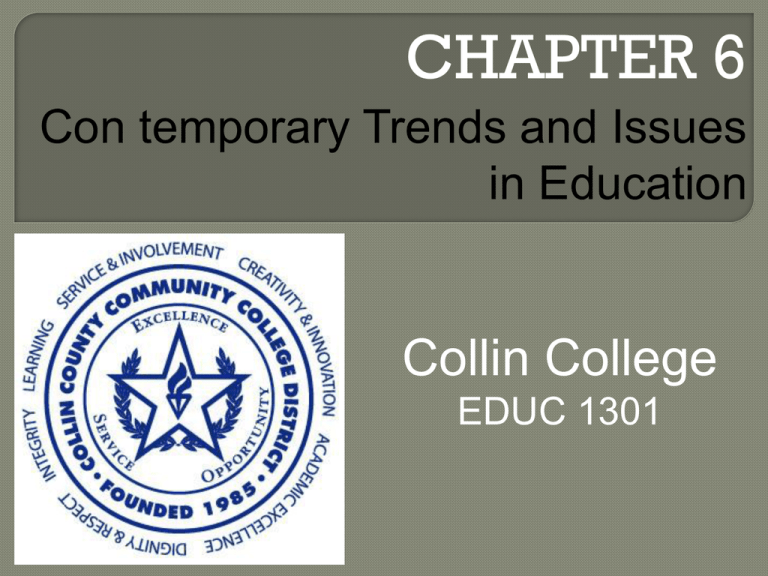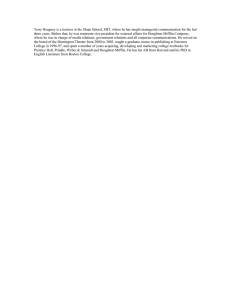
CHAPTER 6
Con temporary Trends and Issues
in Education
Collin College
EDUC 1301
Students
who require special services for
academic, physical, or behavioral needs
may be mainstreamed into regular
classrooms with two teachers working
together.
Inclusion classrooms offer all students
significant possibilities. The inclusion
teacher works closely with the regular
classroom teacher.
Inclusion: Students
with disabilities are
in a “regular” class whole day
• Pros and cons- helps or hurts “regular” students?
Mainstreaming: Students
are in regular
class for part of day
Special education: Segregated class
• Stigmatizes and inhibits growth?
• Why is there a disproportionate # of minority
boys?
• How is the special education assessment made?
Plan
describing academic goals, services
school will provide, and assessment
strategy for each student with disabilities
• Created through collaboration of teachers
(general ed. & inclusion specialist for that class),
school psychologist, administrators, student’s
guardians
Learn differently from peers:
• Usually they learn faster and understand at more
complex level
• Often demonstrate special creativity
Inclusion
students can also be gifted and
talented!
Fewer poor & minority students
identified
• Parents less likely to demand inclusion
• Students had fewer experiences that convey
sense of “giftedness”
Enrichment: Broadens
curriculum
• Classroom-based activities to expand on unit
Acceleration: Speed
through curriculum,
students may skip grades, graduate early
• Segregated grade-level classes
• Advanced placement classes (college credit)
• International Baccalaureate Program
Uses a variety of strategies to meet different learning
needs- represents good teaching!
• Differences affect:
What students need to learn
Pace of their learning
Level of support needed
• Students learn best when:
Supportive adults encourage them
The curriculum connects to their interests, lived experiences
They feel respected & part of community
Learning opportunities are natural outgrowths of the
classroom community.
Project-based: Students tackle a complex realistic task
(often constructing something);
Problem-based: Students solve real problems
In both approaches:
• Students collaborate in small teams, direct learning
• All answers are respected and analyzed
• Focus is on an engaging, complex, real-life issue
• Students gain new academic, thinking, & social skills
• Adds creativity & depth to study of subject
The major goal was to close the achievement gap
between poor, minority students & white middle-class
students;
• Instituted annual state and school report cards based on
standardized test scores.
• If schools don’t make “annual yearly progress”:
Schools provide additional services (free tutoring)
Schools must take corrective actions
Students can transfer to better-performing school in district
• States & school districts given unprecedented flexibility
in spending federal $
• Federal $ targeted to support programs and methods
scientifically proven to improve student achievement
Fostered
culture of test preparation
• Annual standardized tests in math & reading for
grades 3-8, but tests aren’t “standard”
• Narrowed curriculum, teaching practices
Widened
gap between low- and highachieving students!
Went back to being called the
Elementary and Secondary Education Act
in 2010
State 32%
Local 60%
Federal 8%
STAAR tests:
• 3-9 reading; 4,7 writing; 8 social studies 5,8, science
Ratings:
• Exemplary, recognized, academically acceptable,
academically unacceptable
Subgroups:
• All students, African American, Hispanic, White,
Economically Disadvantaged
STARR
• 2011-12 begin EOC exams, eventually 12 EOC
exams
Copyright by Houghton Mifflin Company. All rights
reserved.
12
-
Public School
Choice
Magnet
Schools
Charter
Schools
• Choice of schools within a district
• Sometimes between districts
Public schools with specific themes
Public schools chartered to be run
independently
Voucher Plans Public money to attend private school
Copyright by Houghton Mifflin Company. All rights reserved.
12 - 15
Charter
exempts school from certain
rules, school produces set results by
deadline
• Goal: Innovative education, often for targeted
•
•
•
•
•
populations
State or local ed. agency grants charter
Publicly funded schools
Teacher certification standards vary
40 states have charter school laws
No clear evidence of success; supported by
2010 Race to the Top Federal Grant
Competition.
Harlem
Success Academy
• 100% students pass zone test compared to 58%
of public school students
Reasons
public schools unsuccessful (Eva
Muskowitz)
• 1)bureaucracy
2)union 3)can’t fire teachers
365,000
children on waiting lists for
Charter Schools
Copyright by Houghton Mifflin Company. All rights
reserved.
12
-
Against
For
Families have widest
possible range of
education choices
Free-market
competition will force
schools to improve
•
•
Good schools get
stronger
Bad schools “go out of
business”
Schools, rather than
families, choose
• Those not accepted remain
in public system
Voucher amounts not
enough for most private
schools
Reduces funds for public
schools
Public money could
support religious schools
Copyright by Houghton Mifflin Company. All rights
reserved.
12
-
1980s: Many
junior highs converted to
middle schools to better serve young
teens with interdisciplinary teamteaching
Research
showed K-8 yields better
academic & social success
• Many middle school teachers aren’t certified in
subject area
Most
homeschooling families are white,
middle or upper-middle class, religious,
well-educated
• 1/3 chose because of school environment (safety,
peer pressure, drugs); 1/3 to give religious ed.
Can
parents adequately teach in all
subjects?
• Range of curricula from companies via the Internet
Do kids gain social skills?
• Study reported 71% of homeschooled grads were
active in the community vs. 37% of traditionally
educated students.
% of students aged 12-18 who reported being
victims during past 6 months (“Violent crimes”
includes “serious violent crimes”)
Source: Dinkes, R., Cataldi, E.F., Kena, G., and
Baum, K. (2006). Indicators of School Crime
and Safety: 2006. NCES 2007-003/NCJ 214262.
Washington, DC: U.S. Departments of Education
and Justice. Figure 3.1, p. 15.
Emotional
climate
• Establish a culture of respect
• Deal quickly with everyday teasing, bullying
Create
connections between adults &
students
Break the code of silence
Involve everyone in school in creation of
“emergency response” policies &
practices
Refers
to students’ abilities to manage
their emotions, develop caring and
concern for others, make responsible
decisions, establish positive
relationships, and handle challenging
situations effectively.
SEL
skills are explicitly taught through
planned, systematic, and evidence-based
classroom instruction.
Safety
Privacy
• Family Educational Rights & Privacy Act (FERPA):
School must protect confidentiality of students’
educational records
A.k.a. “the Buckley Amendment”
Students & parents can review records
Can challenge content, insert explanation into file
Exercise some control over disclosure
For more information about FERPA
Free
expression:
• Balance between individual’s rights & school’s
need to maintain productive learning
environment
• Speech cannot disrupt learning
• School newspapers can be censored
• District can impose dress code
Freedom
of religion:
• In general, schools must be neutral
Safety
Academic
freedom
Freedom of expression
Privacy: Limited; if private actions affect
integrity of school or hamper teacher’s
effectiveness, teacher may be disciplined
These rights are limited by context: The
teacher’s responsibility to students
Take
reasonable precautions to keep
students safe;
Report suspected child abuse/neglect!
Watch
the TeachSource Video Case,
“Legal and Ethical Dimensions of
Teaching: Reflections from Today’s
Educators”
• In what ways are the “rules of the classroom”
meant to support students’ First Amendment
rights?”
Trends
often have long lasting impacts on
teaching and learning! You will likely
encounter:
• Exceptional learners
• An inclusion classroom
• Project- and problem-based learning
• Standards-based accountability
• Issues related to students’ rights and safety
• Families choosing alternative schooling (charter
schools, homeschooling)
• Issues surrounding social and emotional learning.
Choose an Issue
Exceptional learners
An inclusion classroom
Project- and problem-based learning
Standards-based accountability
Issues related to students’ rights and safety
Families choosing alternative schooling (charter schools,
homeschooling)
• Issues surrounding social and emotional learning
•
•
•
•
•
•
Discuss the Issue Developing Pro and Con
Talking Points
• 10 minutes to work
• 2 minutes to present
Copyright by Houghton Mifflin Company. All rights
reserved.
12
-

